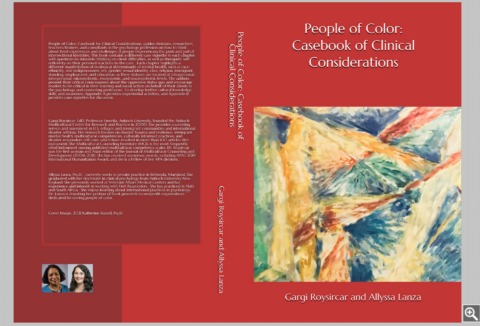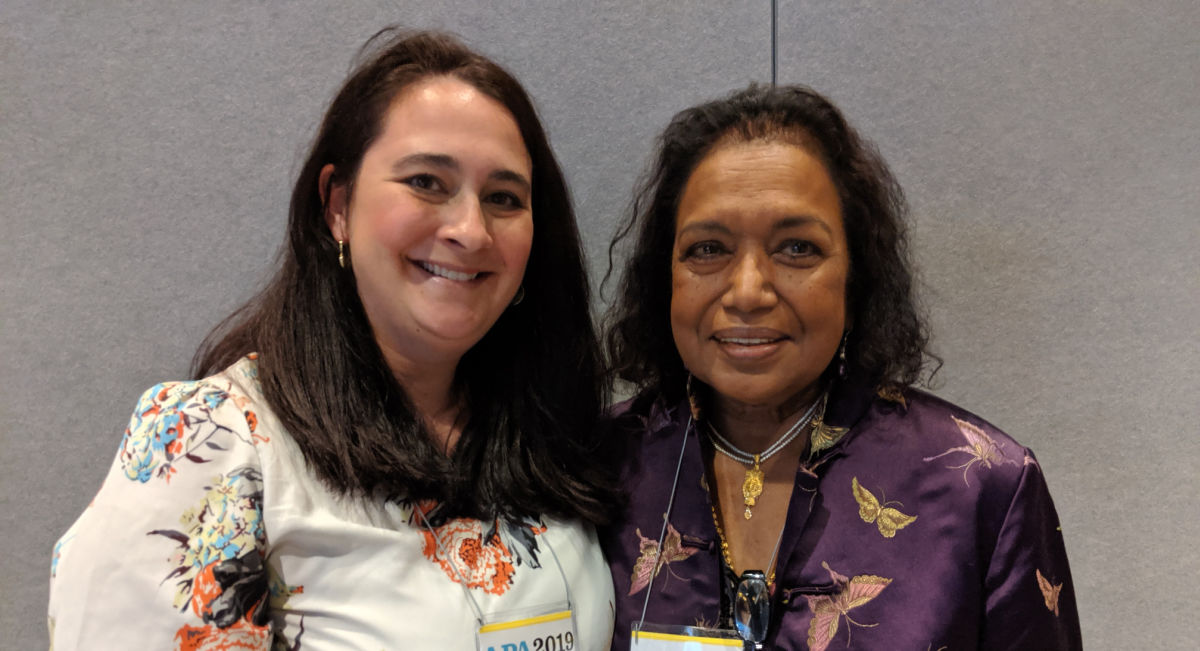People of Color: Casebook of Clinical Considerations, a recent collaboration by co-authors Gargi Roysircar, Antioch University Professor Emerita, and Licensed Psychologist, Allyssa Lanza, AUNE PsyD ‘14 with contributions from AUNE PsyD in Clinical Psychology alums Katherine Russell, PsyD ’17, and Sarajane Rodgers, PsyD ’21, was published through Amazon in February of 2021. For the authors the driving factor behind going indie (eschewing the traditional publishing route) was time. “I believed that my writing needed quick access because clinicians urgently needed guidance with culturally competent clinical applications,” says Roysircar, alluding in part to growing recognition by mainstream society of institutionalized systemic racism and implicit bias. The book directly addresses the need for approaches to consider the implications of both the client’s and the therapist’s background as they work together in a clinical setting. Roysircar has an extensive publication history and a body of work that includes research on disaster outreach in international settings, the effects of acculturation and enculturation on immigrant mental health, multicultural competencies in practice and assessment, and training graduate students in culturally informed practice.
When Students Become Colleagues and Collaborators
 Allyssa Lanza was a former mentee of Roysircar. The women previously published together on disaster research in Haiti. Roysircar sought Lanza’s input as a practicing clinical psychologist – to balance and build upon her perspective and approach as a researcher, which worked out well as Lanza was also able to spearhead the publishing effort. It’s a story of combining different strengths, generations, and backgrounds, and the book has been well received as a crucial, timely contribution to the field of psychology. The POC Casebook was listed for several weeks by Amazon as being among the top five newly-published textbooks in clinical and applied psychology; it is being used in academic coursework and has been recognized by graduate students as well as established multicultural scholars. “…This book will become a first choice or secondary book for all courses in counseling and therapy. It is also a “good read” that will change practice in our field…” wrote Allen Ivey, EdD, Board Certified in Counseling Psychology, Distinguished University Professor Emeritus of University of Massachusetts, Amherst.
Allyssa Lanza was a former mentee of Roysircar. The women previously published together on disaster research in Haiti. Roysircar sought Lanza’s input as a practicing clinical psychologist – to balance and build upon her perspective and approach as a researcher, which worked out well as Lanza was also able to spearhead the publishing effort. It’s a story of combining different strengths, generations, and backgrounds, and the book has been well received as a crucial, timely contribution to the field of psychology. The POC Casebook was listed for several weeks by Amazon as being among the top five newly-published textbooks in clinical and applied psychology; it is being used in academic coursework and has been recognized by graduate students as well as established multicultural scholars. “…This book will become a first choice or secondary book for all courses in counseling and therapy. It is also a “good read” that will change practice in our field…” wrote Allen Ivey, EdD, Board Certified in Counseling Psychology, Distinguished University Professor Emeritus of University of Massachusetts, Amherst.
Lanza is especially grateful that readers are taking advantage of the self-reflective questions in the book. “I hope that the book not only shares information with the readers, but that it might facilitate them integrating it into helpful and meaningful ways in their work,” she says. Growth and evolution of understanding is at the core of this book. Roysircar and Lanza both expressed that their perspectives on counseling people of diverse backgrounds has changed over the years as a result of their work, studies, and… living.
Decolonizing the Therapeutic Exchange
“Previously my emphasis was on race, ethnicity, and international standing,” says Roysircar, who has integrated into some of the amalgamated cases in the book some of her own and family members’ experiences as women immigrants and international clients. From personal experience she understands that there are many instances of trauma for which people are not able to find professional help, but they have coped with it well through seeking personal, family, and community resilience resources. Recognizing and honoring family, community, and resilience resources is an area in which Western ideologies are not historically strong – and this gets to the heart of what the book outlines: the need to make therapy an inclusive, informed, understanding space for all backgrounds. Roysircar’s understanding of how that can be done has changed and expanded over time. “Now I have developed a focus on intersectionality, such as a person’s numerous identifications because of membership in various marginalized groups: for example, Immigrant+Woman+Low SES+Muslim+Dark Skin Color+Single Mother+Traditional Sex Role Values,” she says. “Such a person experiences multiple disparities in mainstream White America, sometimes all together and sometimes one-at-a-time, depending on the triggering context. All identification stresses of a marginalized client need to be acknowledged and addressed because of their cumulative traumatic effects over time,” Roysricar says. In other words, this client would benefit greatly from being treated by a care provider who acknowledges and considers her varied, nuanced identity signifiers and engages with her as a complex individual.
Lanza has been focusing on learning more about how the effects of colonization manifest in her work. She’s currently working on identifying ways to take steps toward dismantling systems that perpetuate disparities in mental health treatment. The process involves learning about the history and current practices of colonization as well as exploring her internalized beliefs and assumptions; and recognizing instances in which these are harmful to others. She echoes Roysircar’s sentiments on the subject saying, “there are so many ways in which different groups have resilience that are often dismissed, and even pathologized, in Western (White) psychology. It is important for me to understand how strength and resilience manifest in different people so that I can support them in their healing.” When asked what a person of color might look for in identifying a good therapist, Lanza highlights the importance of finding someone who feels trustworthy, and to not continue to work with a therapist whose approach doesn’t resonate. Trust between client and care provider is crucial to the healing process and may be the biggest determinate in whether treatment is successful.
A Tool for Cultivation Authentic Connection and Healing
People of Color: Casebook of Clinical Considerations is a tool meant to help therapists and clients connect authentically and do better work together. Roysircar similarly advises people seeking treatment to have an upfront conversation with potential providers “regarding their self-identifications and the interface of their identities with people who identify differently than they.”
There is much to consider from the counselor’s perspective, as well as, for better or worse, their own identity is also inherently tied into the exchange. Roysircar and Lanza both recommend radical, ongoing self-reflection. “As therapists, we can recognize how our own range of identities interact with those of our clients, engaging our differences as well as commonalities that have an impact on our work together,” Roysircar says. Lanza cautions against the tendency to oversimplify. “There is not just ‘one thing’ [a therapist] needs to focus on when working with people of color,” she says. “Instead, clinicians need to consider all of the various parts that build one’s identity and consider how those elements work together in this particular individual.”
And, the work continues. Roysircar has another book coming out later this year with Cognella Press, Inc., titled: Anti-Black Racism in Contemporary America, which includes chapters with cases illustrating the theory of systemic racism and how to address it in individual cases. She is also revising a manuscript for an APA journal that addresses her clinician trainees’ reflections on the challenges and transnational adaptations of their clinical work with women, men, children, and families in Haiti. Additionally, she’s working on qualitative analyses of young Indian immigrant women’s discrimination as well as resilience experiences in the community setting while interacting with White Americans. Lanza envisions a second edition of People of Color: Casebook of Clinical Considerations at some point in the future. She’s grateful that the research in this area is growing, and could see a benefit to updating the book to include new information. As each chapter is based on a case example, she sees benefit in adding more as understanding grows and evolves.
Gargi Roysircar and Allyssa Lanza have many useful pearls of wisdom to offer, some of which can be found within the pages of their co-authored book. For more on intersecting identities, cultivating egalitarian therapeutic relationships, the vulnerability that arises when a therapist shares a subjugated identity with a client, transparency regarding identities of privilege and devaluation, and much more, give the book a read!



